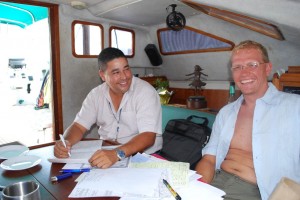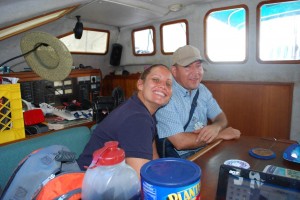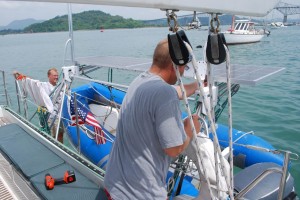Wednesday was yet another great day. It started out a little rushed, as Dallas was concerned that we would not have time to visit the port authority office as well as the French Embassy by noon when the woman responsible for visas finishes work. (A 20-hour work week seems quite cushy even for the French!) However, just after we finished breakfast, two men from the port authority office arrived to clear us in, saving us the hassle of making the trip to their office. The men were very amiable and seemed pleased that we had our paperwork in order and that Dallas and Wes could converse with them in Spanish.
Then it was on to Panama City via the free water taxi and $5 cab. Initially we drove through a poorer area of town as evidenced by the run-down condition of the homes and buildings, but it was clearly more orderly than Colon–no one walked in front of the cab, there were traffic signals, and I don’t remember seeing graffiti/airbrushing all over the place. We then found ourselves in an old but very well maintained district (el Casco Antiguo) with Spanish architecture, flowers hanging from balconies, and historic monuments. This was the most aesthetically pleasing place that I had seen since Old Town in Key West, and I welcomed the change of scenery.
As we got out and proceeded into the French Embassy, I mentally prepared to state what we needed in French, but as it turns out, the staff spoke English rather well. After waiting in the air conditioned waiting room for 20 minutes using the embassy’s reading materials to brush up on my French, we learned that it could take as long as 2 weeks to get an extension for our 30-day tourist visa for French Polynesia. We don’t have that kind of time to wait, so we will just have to find a way to get to Tahiti to obtain an extension (or prolongation, as the woman at the embassy called it) before our 30 days are up. We will most likely catch a plane or charter boat to Tahiti and back to our boat rather than sailing there, as everything we have heard suggests that we are going to want to spend much more than 30 days in the Marquesas, the easternmost island group of French Polynesia.
Upon leaving the embassy, we walked around for a bit looking for an internet cafe. We stopped in a convenience store for some bottled water, and Wes surprised us with ice cream sandwiches–a very nice treat. After asking several people, all of whom were friendly, we found our way to the internet cafe near Santa Ana Plaza. Wes and Tiff located their next destination, a store that sold a specific cable that Wes needed for his computer. Dallas and I opted to explore the area a bit and located a store that will be perfect for final provisioning. It is very similar to Walmart with the exception of a section called “Esoterica” that contained various soaps and lotions designed for enhancing one’s fortune or sex life (souvenirs, anyone?).
We then headed back toward the historical area and found ourselves at el Museo del Canal Interoceanica. We were told that the displays were all in Spanish but stopped in anyway since it was only $2/person. Three hours later, we had learned quite a lot about the history of the Panama Canal! Dallas managed to translate almost all of the key points for me (so we think), and the pictorial exhibits helped to convey the story as well. In a nutshell, international interest in the isthmus of Panama dates back to the 1500’s as a result of its geographical location and potential to greatly expand global commerce. Initially (circa 1855), an American company created a railroad that extended across the isthmus, providing another means for ’49ers to travel to California. However, it was not ideal for commerce, and thus, discussions continued regarding where to dig a canal. The American engineers apparently favored a route across the 200+ mile stretch between Columbia and Nicaragua, as there was a large lake there already. However, the Frenchman Ferdinand de Lesepps, who was credited with the creation of the Suez Canal, preferred the short (33 mile) Panamanian route and used his credibility and bravado to convince other French companies to buy in.
Digging began in 1880 without sufficient study of the geology of the region. There were serious, unanticipated problems right off the bat. Clearing the jungle was extremely labor intensive. Further, workers began to perish as a result of diseases such as malaria, which they did not realize was carried by mosquitoes. De Lesepps did not reveal these difficulties to his funders, however, until they had lost over 20,000 workers and had no choice but to abandon the project.
American companies took over at the turn of the century and were able to address the medical problems plaguing the canal workers. The project became political in 1903 when the Panamanians requested help from the U.S. in order to gain independence from Columbia. The Americans agreed to assist with the U.S. Navy for a price…possession of the Canal Zone when completed. Over the next 10 years, Americans sent over 7,000 men and women to the Canal Zone to work alongside Panamanians, Europeans, and Africans from the Caribbean region to complete the project. (This explains the racial diversity that exists here today.) Enough land was dug out of the canal to create 63 Egyptian pyramids or a pave a track around the world three times!
While this may sound like cause for good relations between the U.S. and Panama, the exhibits revealed that there was anti-American sentiment for a couple of reasons. First, the Americans working on the Canal were termed the “Gold Class” as they had nicer accomodations, better salaries, and more amenities than the “Silver Class” (everyone else). Second, the Americans had a military presence in the Canal Zone to protect their possession of the area and established their own laws and courts that gave them the right to expel people from the area. Panamanians began to organize demonstrations against the American occupation in the late 1940’s, and these continued and became more violent until the 1970’s when President Johnson made some concessions in terms of voiding the 1903 treaty and allowing Panamanians to share control of the Zone. The Canal Zone was returned to Panama in 1999, but to me, the influence of American culture still remains in terms of gender equality (e.g., we saw as many female police officers as male ones that first day in Colon) and entrepreneurial spirit (e.g., our advisor for the Canal transit told me that he wanted to start a bottled water company).
Dallas and I were pleased that it had stopped raining by the time we left the museum and popped into a souvenir shop to get a couple of crafts made by the nearby Kuna Indian tribe. We then explored our options for dinner and settled on an open-air restaurant called Buzio’s that played really good Brazilian music. All of the food was excellent, and Dallas the vegetarian was enticed to sample my red snapper with mediterranean vegetable sauce, which he seemed to really like!
We headed back to the Balboa Yacht Club where the boat is moored and found Zac and his entourage there at the restaurant. There were 10 minutes left before happy hour ended (this seems to be a global phenomenon), so we ordered a couple of pitchers of the local Balboa beer (pretty good) and enjoyed some more great conversation. Zac had to leave at one point to skype with a reporter from CNN (http://ac360.blogs.ncc.com/2009/05/21/sailing-around-the-globe). He stays pretty busy while in port!
As I’m sure you can tell, we are really enjoying this side of Panama. It feels great to be in the Pacific, as if we have accomplished something. In actuality, we have only traversed about 5% of the world, though, so we have a long way to go! We are planning to stay here for just a couple more days before heading to the Las Perlas for a day of scuba diving. Dallas was pretty sick yesterday but seems to be doing much better today, as he and Wes have already managed to install the two new solar panels that were delivered to us here in Balboa. Tiffany and I are trying to talk them into visiting the local discoteca tonight…we’ll let you know how that goes!




